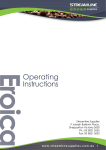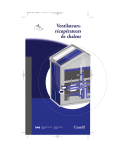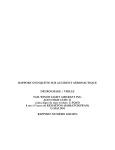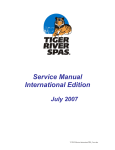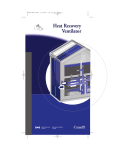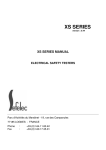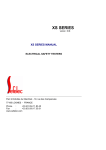Download Bryant HEAT RECOVERY VENTILATOR HRVBB Troubleshooting guide
Transcript
For additional copies of this or other free publications on energy efficiency, contact: Energy Publications Office of Energy Efficiency Natural Resources Canada c/o St. Joseph Communications Order Processing Unit 1165 Kenaston Street PO Box 9809 Stn T Ottawa ON K1G 6S1 Tel.: 1-800-387-2000 (toll-free) Fax: 613-740-3114 TTY: 613-996-4397 (teletype for the hearing-impaired) Cat. No. M144-234/2011E (Print) ISBN 978-1-100-19261-1 Cat. No. M144-234/2011E-PDF (On-line) ISBN 978-1-100-19262-8 Aussi disponible en français sous le titre : Ventilateurs-récupérateurs de chaleur Revised February 2012 © Her Majesty the Queen in Right of Canada, 2012 You can also view or order most Office of Energy Efficiency’s publications on-line. Visit our Virtual Library at oee.nrcan.gc.ca/infosource. The Office of Energy Efficiency’s Web site is oee.nrcan.gc.ca. For information regarding reproduction rights, contact Public Works and Government Services Canada (PWGSC) at 613-996-6886 or at copyright. [email protected]. Recycled paper Heat Recovery Ventilators Produced by Natural Resources Canada’s Office of Energy Efficiency EnerGuide The Heating and Cooling Series is published by Natural Resources Canada’s Office of Energy Efficiency. EnerGuide is the official Government of Canada mark associated with the labelling and rating of the energy consumption or energy efficiency of household appliances, heating and ventilation equipment, air conditioners, houses and vehicles. EnerGuide also helps manufacturers and dealers promote energy-efficient equipment and provides consumers with the information they need to choose energyefficient residential equipment. ENERGY STAR® Natural Resources Canada’s Office of Energy Efficiency promotes the international ENERGY STAR symbol in Canada and monitors its use. Major manufacturers and retailers of energy-efficient products, utilities and energy retailers, and interest groups from Australia to Europe, recognize the benefits of ENERGY STAR for consumers and have joined in promoting the symbol. ENERGY STAR is the international symbol of premium energy efficiency. Products that display the ENERGY STAR symbol have been tested according to prescribed procedures and have been found to meet or exceed high energy efficiency levels without compromising performance. 1 2 Contents 1. Introduction . . . . . . . . . . . . . . . . . . . . . . . . . . . . . . . . . . . . . 4 2. The need for mechanical ventilation . . . . . . . . . . . . . . . 5 Circulating fresh air in new homes . . . . . . . . . . . . . . . . . . . . . 5 Circulating fresh air in conventional homes . . . . . . . . . . . . . . . 5 Household pollutants . . . . . . . . . . . . . . . . . . . . . . . . . . . . . . . 6 How much ventilation does your home need? . . . . . . . . . . . . . 7 3. The HRV system . . . . . . . . . . . . . . . . . . . . . . . . . . . . . . . . . 8 Components of an HRV system . . . . . . . . . . . . . . . . . . . . . . . 8 Air distribution . . . . . . . . . . . . . . . . . . . . . . . . . . . . . . . . . . . 10 High-efficiency motors . . . . . . . . . . . . . . . . . . . . . . . . . . . . . 12 Checking airflow room by room . . . . . . . . . . . . . . . . . . . . . . 13 The need for a balanced system . . . . . . . . . . . . . . . . . . . . . . . 14 Do-it-yourself balance check . . . . . . . . . . . . . . . . . . . . . . . . . 16 4. Operating your HRV . . . . . . . . . . . . . . . . . . . . . . . . . . . . 17 Controls . . . . . . . . . . . . . . . . . . . . . . . . . . . . . . . . . . . . . . . . 17 Low-speed operation . . . . . . . . . . . . . . . . . . . . . . . . . . . . . . . 18 High-speed operation . . . . . . . . . . . . . . . . . . . . . . . . . . . . . . 18 Heating season operation . . . . . . . . . . . . . . . . . . . . . . . . . . . . 19 Non-heating season operation . . . . . . . . . . . . . . . . . . . . . . . . 20 All-season operation . . . . . . . . . . . . . . . . . . . . . . . . . . . . . . . 20 ENERGY STAR® for HRVs . . . . . . . . . . . . . . . . . . . . . . . . . 20 5. Routine maintenance . . . . . . . . . . . . . . . . . . . . . . . . . . . 22 Seven-step maintenance schedule . . . . . . . . . . . . . . . . . . . . . . 22 6. HRV maintenance chart . . . . . . . . . . . . . . . . . . . . . . . . . 27 7. HRV troubleshooting guide . . . . . . . . . . . . . . . . . . . . . 29 8. Need more information? . . . . . . . . . . . . . . . . . . . . . . . . 31 3 1 Introduction The importance of ventilation in today’s more energy-efficient homes is universally recognized. Introduced as a requirement for airtight R-2000* homes, continuous ventilation systems are now common in new housing and major home renovations. Because of the energy savings generated, the system of choice is often a heat recovery ventilator (HRV) or energy recovery ventilator (ERV). During the remainder of this publication, we will refer only to HRV; however, please note that this applies to both HRVs and ERVs. An HRV is a mechanical ventilation device that helps make your home healthier, cleaner and more comfortable. It does so by continuously replacing stale indoor air with fresh outdoor air. HRVs are set apart from other mechanical ventilation devices. Their ability to exchange heat between the supply and exhaust air streams reduces the cost of heating or cooling the healthy fresh air circulating through the home. HRVs are sometimes called air-to-air heat exchangers because they preheat or cool incoming air using exhaust air. This booklet discusses the need for mechanical ventilation in homes. It also explains the components of an HRV system, how to operate and maintain the system, and how to solve operating problems. You will find this information useful, whether you occupy a home with an HRV or plan to have one installed. There are many types of HRVs on the market, as well as different installation strategies. The size of your house, type of heating system and geographical location, for example, can affect the kind of system you have and the way it has been installed. The diagrams in this booklet give examples of the types of systems available; they are provided for information only. This booklet is intended to supplement your HRV owner’s manual, not replace it. If you need a manual or more information on operating procedures for your HRV, contact the installer or manufacturer. * R-2000 is an official mark of Natural Resources Canada. 4 2 The need for mechanical ventilation Circulating fresh air in new homes New homes are built to be airtight. This limits the uncontrolled flow of air in and out of the home and reduces heat loss and moisture damage to the building structure. To complement this airtightness and ensure a healthy living environment, modern homes use a mechanical ventilation system to remove pollutants from the home by replacing stale indoor air with fresh outdoor air. These pollutants come from a range of sources – from household contents and materials to people and their activities and pets (see “Household pollutants” on page 6). In most homes, the mechanical ventilation system is an HRV. This system allows fresh air to be distributed throughout the house. A properly installed, operated and maintained HRV exhausts indoor air pollutants and excess humidity to the outdoors while distributing fresh air throughout the house. During the heating season, the HRV captures heat from the outgoing air and uses it to preheat the incoming fresh air. During the cooling season, an HRV can reverse this heat-exchange process, removing some of the heat from the incoming air and transferring it to the outgoing air. Circulating fresh air in conventional homes In recent years, more and more homes have undergone energy efficiency improvements such as upgraded insulation, improved air sealing and the installation of energy-efficient windows, doors and heating systems. In many of these homes, air infiltration through doors, windows and other openings in the building shell is random and does not always provide adequate ventilation, which is just as important in a conventional home as in a new home. Even with an acceptable rate of air exchange, the fresh air may not reach the rooms where it is needed. As a result, mechanical ventilation is needed in many conventional homes to distribute fresh air evenly throughout the 5 home and maintain a healthy living environment. An added benefit of mechanical ventilation systems is their capability to filter the incoming fresh outdoor air. Household pollutants You can eliminate or reduce certain sources of indoor air pollution by understanding where household pollutants come from. However, no matter how careful you are, there will always be some pollutants in your home and, therefore, a need for ventilation. Table 1 identifies the most common pollutants and their sources. Additional information on indoor air quality is available from the Canada Mortgage and Housing Corporation’s Canadian Housing Information Centre, at the address provided on page 32. TABLE 1 Common pollutants and their sources Pollutant Source Excess moisture and moulds A crawl space with an exposed earthen floor, people, clothes drying indoors, cooking and washing, plants, firewood stored indoors, etc. Urea formaldehyde Some types of particle board, panelling, carpeting, furniture, textiles, etc. Radon Soil and groundwater Tobacco smoke Smoking Household chemicals Cleaning products, certain hobby supplies, paints and solvents, aerosols, etc. Odours, viruses, bacteria and dandruff People and pets Combustion by-products (including carbon monoxide, nitrogen oxides, carbon dioxide and particulates) Fuel-burning appliances, including furnaces, heaters, ranges/ovens, gas clothes-dryers, fireplaces, wood stoves, etc.* *CAUTION: Do not rely on an HRV to remove combustion by-products from your home or to supply the combustion air requirements of fuelburning appliances. Combustion appliances should have their own air supply for combustion. If combustion by-products are escaping into your home, an appliance or its venting system is not operating properly and must be repaired immediately. Fuel-burning appliances should be installed to vent to the outdoors. Unvented fuel-burning appliances – such as barbecues, portable gas-fired or kerosene space heaters or unvented gas fireplaces – are not recommended for use indoors. Natural draft appliances and water heaters should be avoided. 6 How much ventilation does your home need? The capacity of a home’s ventilation system is usually based on the number of rooms in the house. HRV capacity is measured in litres per second (L/s), or cubic feet per minute (cfm), of fresh air provided to the home. Using the information in Table 2, you can calculate how much fresh air your home needs under normal circumstances to maintain good air quality. TABLE 2 Fresh air requirements per room Room Ventilation air supply Master bedroom 10 L/s (20 cfm) Unfinished basement 10 L/s (20 cfm) Other rooms 5 L/s (10 cfm) each Based on these figures, a ten-room home (unfinished basement, living room, dining room, family room, kitchen, two bathrooms, master bedroom and two bedrooms) requires an HRV with a rated capacity of 60 L/s (120 cfm). To ensure adequate ventilation, the HRV’s ventilation capacity at high speed should be close to this total (see “High-speed operation,” page 18). The suggested low-speed HRV ventilation rate should be from 40 percent to 60 percent of the high-speed rate. HRVs with high-efficiency motors (see “High-efficiency motors,” page 12) can operate at lower speeds, based on demand. 7 3 The HRV system Components of an HRV system An HRV system consists of the following equipment: • insulatedductsforincoming(fresh)andoutgoing(stale)air, with exterior hoods • ductworktodistributefreshairthroughoutthehomeandto return stale air to the HRV • fanstocirculateairthroughoutthehomeandtoexhauststale air to the outdoors • aheat-exchangecore,whereheatistransferredfromoneair stream to the other • filterstokeepdirtoutoftheheat-exchangecore • adefrostmechanism(someunitsuseapreheater)toprevent the heat-exchange core from freezing and blocking when the temperature of the incoming air is cold (not shown in Figure 1) • adraintoremoveanycondensationfrominsidetheHRV (may not be required with all models) • operatingcontrolstoregulatetheHRVaccordingto ventilation needs 8 FIGURE 1 Components of a ventilation system using an HRV INTERIOR OF THE HOME Controls Circulation fan OUTDOORS Screen Heat– exchange core Casing Exhaust air outlet Fresh air to house Hood Insulated duct Stale air from house Filter Filter Circulation fan Condensate to drain Fresh air intake Screen Trap filled with water (Note: Your HRV may not have all the parts shown here.) During the heating season, an HRV recovers heat from the outgoing, stale household air and uses it to preheat incoming, fresh outdoor air. The HRV then distributes the incoming air throughout the house. In the example shown in Figure 1, the flow of air in and out of the house takes place simultaneously (note: the path of the airflow may vary from one HRV to another). The two air streams are always kept separate within the HRV. Fresh outdoor air is filtered before it enters the HRV core, where a circulation fan distributes the air throughout the house via ductwork. A separate ductwork system draws the stale indoor air back to the HRV, where it is filtered and pushed by a fan through the heat-exchange core. Here, the stale air releases heat that is transferred to the fresh air being drawn into the house. During the cooling season, the HRV reverses this heat-exchange process, removing some of the heat from the incoming air and transferring it to the outgoing air (see the text box called “Energy recovery ventilators”). 9 Energy recovery ventilators Energy recovery ventilators (ERVs) are a type of HRV that can exchange both heat and moisture. An ERV can give you more control over moisture levels in your home during warm and humid weather, which could be important in your climate. During the cooling season, ERVs help keep excess moisture out of your home by allowing it to pass through the HRV core. The incoming moist air then transfers the moisture to the outgoing exhaust air. Because less energy is required to lower the temperature of dry air compared to moist air, an ERV can reduce the load on your air conditioner and save you money. On the other hand, if your winter climate is extremely dry, ERVs recover some of the moisture that would be exhausted to the outdoors by a regular HRV. This helps you maintain a comfortable humidity level within your home, avoiding static electricity, sore throats and other discomforts caused by air that is too dry. (This dryness could be caused by over-ventilation, which might indicate that the HRV is oversized or needs to be slowed down.) Air distribution The two standard ways to distribute fresh air throughout the home are through the ductwork installed for the HRV (a direct-ducted system) or through the ductwork of a forced-air furnace system. A direct-ducted system is often found in homes that do not have forced-air heating, such as those with electric baseboard, hot water or radiant heating. In this system, the fresh air is distributed through ducts to the bedrooms, living room, dining room, basement and other rooms, where it disperses throughout the house (see Figure 2). Exhaust air ducts take the stale air from rooms that have high moisture and pollutant sources back to the HRV and, from there, to the outdoors. 10 FIGURE 2 An HRV with direct ductwork Kitchen Living room Bedroom Fresh air ducts Stale air exhaust ducts Exhaust air Fresh air HRV Laundry Bathroom An HRV can also be installed to work with a forced-air furnace system, as shown in Figure 3. In this case, the HRV’s fresh-air duct is connected to the furnace’s main return-air duct. The fresh air enters the furnace and is distributed throughout the house through the regular system of ductwork. With this configuration, the furnace blower runs continuously at low speed when the HRV is operating, to ensure a regular flow of fresh air throughout the house. The furnace blower is wired to operate at the normal higher speed for heating and cooling. However, this higher speed can be noisy and may make the rooms feel cool if used to distribute ventilation air continuously. One way to resolve this problem is to use a high-efficiency motor, otherwise known as an electronically commutated motor (ECM). A conventional, or permanent split capacitor (PSC) motor operating at low speed may still be distributing more air than is necessary while using more electricity and creating more noise. Separate, additional ductwork may be needed to transfer stale air from the damp rooms to the HRV (as shown in Figure 3). 11 FIGURE 3 An HRV installed with a forced-air furnace system Kitchen Living room Bedroom Furnace distribution ducts Stale air exhaust ducts Return air* Exhaust air Fresh air Laundry Bathroom Heat transfer Furnace Furnace main return air duct *Furnace return air may come from more than one location. High-efficiency motors Several years ago, manufacturers started to introduce a highefficiency motor option for some residential furnaces. Today, most motor manufacturers have an electronically commutated, brushless, direct current (DC) motor option (High Efficiency). These highefficiency motors are referred to as “EC,” “ECM,” “BLDC” or “DC” motors, depending on the manufacturer. As well as furnaces, these motors circulate the air in homes where an HRV system is either direct-ducted or uses the ductwork of a forced-air furnace. Furnaces with high-efficiency motors are recommended for use with HRVs, because they can be run at a low speed with low noise and use less electricity. If you are purchasing a new furnace or plan on installing an HRV, consider buying a furnace with a high-efficiency motor. A furnace with a high-efficiency motor is more efficient than an equivalent furnace with a conventional, or PSC motor. In homes where the fan is run continuously or for extended periods, a high-efficiency motor can reduce electricity consumption and provide better air circulation. A brushless DC motor can reduce average furnace electrical consumption by more than 70 percent, 12 when used for continuous circulation. During the summer months, this motor also saves energy by reducing the load on an air-conditioning system. The actual electricity cost savings depend on how often you use the circulation fan. If your furnace is fitted with a PSC motor, you may be able to retrofit your furnace with an efficient brushless DC motor to reduce electricity consumption at a reasonable cost. Most motor manufacturers have retrofit DC motors that connect to existing PSC motor connections. Talk to your local installer/ service technician and consult with your HRV or furnace manufacturer to see if they have replacement motors specifically designed to fit your unit. However, if your air-circulation duct system has a high static pressure of 200 pascals (Pa) (a 0.8-inch [in.] water column) or more, a high-efficiency brushless DC motor retrofit is not recommended. Talk to your local installer/service technician. High static pressure indicates that the ductwork is undersized for the furnace fan. Checking airflow room by room As a rule, a direct-ducted system should provide at least as much airflow per room as that shown in Table 2 on page 7. An HRV system connected to a forced-air furnace distributes the incoming fresh outdoor air to each warm-air supply duct proportionally. Keep in mind that, if you adjust the dampers in a room to increase or decrease ventilation airflow, you also affect the amount of heat (or cool air, during summer) that reaches the room. Canada Mortgage and Housing Corporation has developed a simple technique for you to determine if each room connected via ductwork to an HRV system receives the correct amount of fresh air. You will need a common household plastic trash bag (66 centimetres [cm] × 91 cm, or 26 in. × 36 in.), a wire coat hanger, tape and a watch. Twist the coat hanger into a rectangular shape and tape the open end of the trash bag around the hanger. Gently deflate the bag, place it over the air register and time how long it takes the bag to fill with air. 13 Table 3 shows the relationship between inflation times and airflow rates. Although this technique is not precise, it will help you estimate the rate of airflow to each room. Then you can make appropriate adjustments, if necessary. TABLE 3 Time to inflate a plastic trash bag (66 cm × 91 cm [26 in. × 36 in.]) Airflow Approximate time to inflate bag 5 L/s (10 cfm) 13 seconds 10 L/s (20 cfm) 8 seconds 15 L/s (30 cfm) 5 seconds 25 L/s (50 cfm) 3 seconds L/s = litres per second cfm = cubic feet per minute If more air is required, adjust the grille openings on the supply register in the room. Remember, bedrooms require more fresh air when occupied by more than one person. The need for a balanced system HRVs are designed to operate in a balanced state – the same amount of air should be drawn into the home as the amount being exhausted. An unbalanced system results in poor airflow and poor heat recovery. It can also lead to other problems, including an undesirable, continuous air-pressure difference between the inside of your home and outside. System imbalance is usually caused by differences in the amount of ductwork used in the fresh air and exhaust air streams. It may also be caused by a clogged filter, a blocked intake or exhaust hood, or a malfunctioning damper or fan. Withdrawing more air from the house than comes in creates negative household air pressure, as shown in Figure 4 (page 16). This excessive pressure can cause the spillage of carbon monoxide and other combustion by-products from fuel-burning appliances (e.g., a furnace, water heater or fireplace). Instead of leaving the house through the chimney, these combustion by-products can be 14 pulled back into the house, where you could inhale them. Negative pressure can also increase the rate of entry of undesirable gases and moisture from the soil surrounding the basement (see Table 1, “Common pollutants and their sources,” on page 6). Either scenario can threaten the health of the occupants. Pulling more air into the home than is exhausted creates positive household air pressure, though. This excessive pressure can cause moist air from the home to be pushed into the walls and roof, where it can condense and lead to the deterioration of the building materials. This hidden problem often goes undetected until severe damage has been done. Positive pressure has other effects. Moisture escaping through exterior door locks can freeze the lock mechanism, making it difficult for you to enter or leave the house. Also, the HRV core can develop frost or freeze, restricting or blocking further airflow (see “Heating season operation,” page 19). Finding a contractor to service your HRV To find a qualified HRV contractor, look under Heating Contractors or Ventilating Contractors in the Yellow PagesTM, or refer to the Web. When you contact one of the companies, make it clear that you need the services of a residential mechanical ventilation installer who has been certified by the Heating, Refrigeration and Air Conditioning Institute of Canada (HRAI). If you have difficulty finding a qualified contractor, contact HRAI or, in Quebec, the Corporation des maîtres mécaniciens en tuyauterie du Québec. Their contact information is provided on page 32. 15 FIGURE 4 Effects of air pressure on a house Example of positive household air pressure Example of negative household air pressure Although your HRV was balanced during installation, have the system checked by a qualified contractor once a year. If you are purchasing an existing home equipped with an HRV, consider having the system serviced, including a balance test. Do-it-yourself balance check You can perform your own rough check of your HRV’s airflow balance by using the trash-bag technique explained on page 13. In this case, tape the open end of an extra-large trash bag (i.e., the type used for leaf collection) to a coat hanger. Place the deflated bag over the HRV’s exhaust hood, located on the outside of your house, and time how long it takes for the bag to fill with air. Then hold the inflated bag over the HRV’s air intake hood and time its deflation. On a well-balanced system, inflation and deflation times should be equal, to within a matter of seconds. 16 4 Operating your HRV After an HRV has been installed, balanced and functioning, its ongoing operation is relatively simple. You can help ensure the safe and reliable performance of your HRV by paying attention to the manufacturer’s and installer’s instructions and following the guidelines in this section. Controls First, become familiar with the HRV’s controls, which allow you to adjust the rate of air exchange and, to some degree, the humidity level in your home. Depending on the installation and HRV model, operating controls may be located on the HRV itself and/or in the kitchen, laundry room, bathroom or hallway. Pollutant sensors may be installed in other rooms. Typically, the main HRV control is placed adjacent to the home’s main thermostat. The operating controls include the following functions, depending on the installation and HRV model. • Speed controls for the ventilation rate. • Acirculation mode setting, which circulates air inside the home but does not exchange indoor and outdoor air. • Adehumidistat that will trigger the HRV into high-speed operation when the humidity level in your home reaches a pre-set level. • Atimer, which can be set to run the HRV at high speed for specified intervals. • Anintermittent exchange mode setting that automatically turns on the HRV at low speed for specified intervals. • Pollutant sensors that increase the ventilation rate when pollutant levels in the home rise. • Amaintenance light, which comes on automatically when the filters, and possibly other components, need to be cleaned or serviced. 17 Low-speed operation To ensure the removal of indoor pollutants and the supply of fresh outdoor air, an HRV should be operated on low speed continuously year-round, especially in airtight homes and homes with normal indoor pollutant levels. HRVs with electronically commutated motors (ECMs) have a wider range of speed controls. Under most circumstances, low-speed operation will meet your ventilation needs (for exceptions, see “High-speed operation” below) and will be more effective than intermittent high-speed operation. Operating in intermittent exchange mode may be appropriate when pollutant sources are low, the house is not overly airtight, or the occupants are away from home for extended periods. If you turn off the HRV, make other provisions for ventilation, such as opening windows. High-speed operation Under certain conditions, the ventilation rate in your home may need to be increased from low-speed operation. Depending on the installation, a high-speed cycle is triggered manually or by a timer, dehumidistat or other controls. High-speed operation is often needed in the kitchen and bathrooms. It also may be required when • youareusingpaints,solvents,cleaningproductsandother household chemicals, • thehouseairseemsstale,containsodoursoristoohumid, • therearemanypeopleinthehouse,suchasduringaparty. Operating the ventilation system on high speed will also improve air quality when people smoke in the house. Tobacco smoke is one of the most noticeable and harmful indoor air pollutants. If possible, confine smoking to rooms that are exhausted directly to the outdoors, through either the HRV or a separate exhaust system (such as a kitchen fan). 18 Frequent or even continuous high-speed operation may be desirable during the first year after a house is built, to exhaust the moisture and pollutants being released by new building materials. An HRV is not an air cleaner and may not deal effectively with extraordinary sources of indoor air pollutants (e.g., strong-smelling glues), particularly if the pollutants are generated in a room that is not exhausted directly to the HRV. In such cases, reduce the activities that are generating the pollutants or install a dedicated exhaust system. Heating season operation Most HRVs feature an automatic defrost mode that activates when the temperature of the incoming fresh outdoor air is below -5°C. A defrosting mechanism is required in cold climates because, as the heat is extracted from the home’s outgoing moist air (to warm the incoming fresh air), the temperature of the outgoing air drops to the point at which moisture or frost can form on the surfaces of the heat-exchange core. A build-up of frost can block airflow through the HRV. One defrost mechanism uses dampers to, temporarily, block the incoming fresh air stream and allow warm air from the house to circulate through the HRV, where it melts any frost that has accumulated. The HRV returns to normal operation after this automatic defrost cycle. As the outdoor air gets colder during the winter, this cycle increases in duration. To help minimize condensation on cold surfaces such as windows, during the heating season, adjust your HRV’s dehumidistat accordingly. You do not want the household air to be too dry because this can cause static electricity and dry, scratchy throats. If the air in your home is too dry during the heating season and you have attributed this to the HRV’s operation, refer to the “HRV troubleshooting guide” on page 29. 19 Non-heating season operation The best strategy is to operate your HRV continuously year-round, even during the non-heating season. Except for adjusting the dehumidistat setting, operation should be essentially the same as during the heating season. On the other hand, conventional permanent split capacitor (PSC) furnace motors are too expensive to run year-round if they are ducted separately. You may find that operating the HRV keeps the home cooler and quieter than does opening windows for ventilation. Keeping windows closed also provides better security and reduces the amount of pollen and dust entering your home. By removing some of the heat from incoming air, most HRVs will reduce the load on the air conditioner and save you money. All-season operation Keep contaminants away from the fresh air intake when your HRV is operating. For example, avoid putting trash next to the HRV intake, do not use pesticides and herbicides nearby and keep your barbecue downwind. If you must generate pollutants near the HRV intake temporarily, turn the HRV off until you complete the activity. ENERGY STAR® for HRVs Effective January 1, 2010, Natural Resources Canada released the technical specification requirements for HRVs and energy recovery ventilators (ERVs) to become ENERGY STAR qualified. This specification promotes increased heat recovery and efficient fan operation. Heat recovery is measured by the sensible heat-recovery efficiency (SRE); the higher the SRE, the higher the rate of heat transfer. Minimum levels of fan efficacy are based on the SRE value. To qualify for the ENERGY STAR symbol, HRVs must be tested by a third party and certified to meet the requirements of Tables 4A and 4B. 20 TABLE 4A Tier 1 (effective January 1, 2010) SRE and minimum fan efficacy requirements Minimum SRE at 0°C (32°F) 60% Minimum SRE at -25°C (-13°F) 55% Minimum fan efficacy with 0°C (32°F) supply temperature SRE < 75% 1 cfm/W (0.47 L/s/W) SRE ≥ 75% any cfm/W (L/s/W) TABLE 4B Tier 2 (effective July 1, 2012) SRE and minimum fan efficacy requirements Minimum SRE at 0°C (32°F) 65% Minimum SRE at -25°C (-13°F) 60% Minimum fan efficacy with 0°C (32°F) supply temperature SRE < 75% 1.2 cfm/W (0.57 L/s/W) SRE ≥ 75% 0.8 cfm/W (0.38 L/s/W) SRE = sensible heat-recovery efficiency cfm = cubic feet per minute L/s = litres per second W = watt For a list of ENERGY STAR qualified HRVs and ERVs, visit oee.nrcan.gc.ca/equipment/heating/13082. 21 5 Routine maintenance If your HRV breaks down, hire a trained contractor to repair it (see “Finding a contractor to service your HRV,” page 15). Do not avoid repairing the HRV simply to save money. If your home was designed and built to have an operating mechanical ventilation system, such as R-2000 homes or other airtight homes, poor indoor air quality, reduced comfort and moisture problems may result if the system is not properly operated and maintained. Seven-step maintenance schedule With routine preventative maintenance, you can avoid unnecessary problems, ensure the effectiveness of your HRV and prolong the life of your HRV. The summary below describes seven HRV maintenance requirements. Items 1–6 are maintenance procedures you should undertake between annual service visits by a professional (item 7). For additional specific instructions, refer to your HRV operating manual or ask the contractor who installed or services the HRV to demonstrate the proper maintenance procedures. Maintenance instructions may be affixed to the HRV’s heatexchange core. DISCONNECT THE ELECTRICAL POWER BEFORE SERVICING YOUR SYSTEM. 1. Clean or replace air filters. Filters, which are usually located within the HRV (see Figure 5), should be cleaned every one to three months. Some filters cannot be cleaned and should be replaced. Washable filters should be vacuumed first, then washed with a mild soap and water. Most washable filters will last several years before you have to replace them. 22 Dirty filters can reduce ventilation efficiency, result in unbalanced airflows and even cause the unit to shut down if it is equipped with an airflow switch. Filters not designed to operate with your HRV can add resistance to the airflow and may impair the unit’s operation. If the HRV uses the furnace ductwork to distribute fresh air to the home, maintain the furnace filter and fan more frequently. FIGURE 5 Example of location of filters in an HRV INTERIOR OF THE HOME OUTDOORS Fresh air to house Stale air from house Filter Filter Screen (Note: Other types of filters are used in some HRVs, and their locations may vary.) 23 2. Clear the exterior intake and exhaust vents of obstructions. Check the outside vents regularly to ensure that the screen openings are not obstructed by grass, bushes, leaves or other debris (see Figure 6). Do not replace the screen with mesh smaller than ¼ inch because it will block airflow. If the exhaust hood has a back-draft damper, check it for free operation and proper positioning (the damper should be closed when there is no airflow). You might want to check the hoods more often in the autumn (when there are leaves on the ground) and during the winter (to ensure that snow or frost build-up does not block the openings). Over time, you will become the best judge of how frequently you should check your HRV hoods. If the openings are regularly clogged or blocked, consider having the vent openings moved higher up the wall. 3. Clean the heat-exchange core. Inspect the heat-exchange core twice a year and clean it as required (consult your owner’s manual for instructions on inspecting and cleaning the core). A build-up of dust and dirt can restrict airflow and reduce the efficiency of your HRV. After inspection and cleaning, make sure the core is replaced right-side-up. It is also a good idea to inspect the heat exchange core during very cold weather to ensure that the defrost mechanism is working. 4. Clean the condensate drain and pan. Twice a year, check the condensate drain (if your HRV has one) and tubing to ensure that they are open and free-flowing. To do this, find the hole that leads to the drain inside the unit. Then pour two or three litres of warm water into the pan leading to the drain. If the water does not flow freely, unblock the drain using a piece of thin wire. The tubing can be disconnected for cleaning. The condensate drain must have a “trap” – an S or loop in the tubing that traps a quantity of water – to prevent air from entering the HRV through this tubing (see Figure 1, page 9). You should also clean the condensate pan, located inside the HRV. 24 FIGURE 6 Checking exterior inlets and outlets 5. Service the fans. The fans on many HRVs are designed to operate continuously without lubrication. Your owner’s manual will indicate whether lubrication or service is necessary. If the fans require lubrication, use proper motor lubricating oil (non-detergent oil). Do not use too much oil because this may damage the motor. Inspect the blower fans periodically for dirt on the blades, and remove it by gently brushing the blades or using a vacuum cleaner. 6. Clean the grilles and inspect the ductwork. Clean the duct grilles when they are dusty or greasy. At least once a year, visually inspect the interior surfaces of the ductwork leading to and from the HRV. These surfaces will collect dirt over time. However, professional ductwork cleaning is usually needed only once every two years. Kitchen exhaust grilles should have filters to catch grease. Clean these filters on a regular basis or as required. Check for punctures in the insulation jacket (the protective cover that seals the insulation) on the fresh air and exhaust air ducts. Repair punctures by using foil duct tape. Otherwise, they can lead to condensation problems, including wet insulation, water on the floor and, occasionally, ice build-up. If the insulation itself is damaged, take the steps indicated in the “HRV troubleshooting guide” on page 29. 25 7. Arrange for annual servicing. Your HRV should undergo annual general servicing by a contractor who is accredited by the Heating, Refrigeration and Air Conditioning Institute of Canada (HRAI) and is familiar with your HRV. If possible, have your furnace and HRV serviced at the same time. This service will result in less inconvenience and cost less than two separate visits. The HRV’s annual servicing should include the following: • maintenance items 1 to 6 (above) and any additional requirements specified by the manufacturer; • a general check for proper operation. Controls and electrical connections in the HRV should be inspected, particularly those located inside the exhaust and fresh air streams. The defrost system should also be tested; • verification that the intake and exhaust airflows are properly balanced. Actual airflows should be measured and the results should be indicated on the maintenance label affixed to the HRV. If necessary, the airflows should be rebalanced. The contractor should provide you with a written report on the HRV’s overall condition. Before requesting such a report, ask whether an extra fee will be charged. To help you remember when maintenance is due, an HRV Maintenance Chart is provided on the next page. Post a copy on the HRV to keep a record of your service and maintenance schedule. 26 6 HRV maintenance chart Unless otherwise recommended by the manufacturer, service your HRV according to the following schedule. If the manufacturer recommends service or maintenance items that are not specified below, write them into the blank spaces provided. CAUTION! Disconnect electrical power before servicing your HRV. Maintenance required Recommended Clean or replace air filters Every 1 to 3 months* Clean or unblock outside hoods and screens Every 1 to 3 months* Inspect and clean heatexchange core Every 6 months Inspect and clean condensate drain and pans Every 6 months Service and clean fans Every 3 to 6 months Adjust dehumidistat controls Seasonally Clean grilles and inspect ductwork Annually Check defrost system Annually General servicing by a qualified contractor Annually Balancing Supply airflow Exhaust airflow Date maintenance performed Annually Annually * You may want to alter this schedule to meet your own needs, depending on the severity of your home’s indoor and outdoor environments or the manufacturer’s recommendations. More frequent servicing may be required if your home is in a location that is dusty, has high traffic flows, etc. 27 Contractors 28 Telephone number 7 HRV troubleshooting guide As with any appliance, problems can arise with your HRV even if it is operated according to the manufacturer’s instructions. Some problems will be simple to diagnose and remedy whereas others may require the services of a qualified contractor. The following HRV troubleshooting guide indicates when you should call a contractor. For more specific information, consult your owner’s manual. CAUTION! Disconnect electrical power before working on your HRV. Problem Possible causes and solutions HRV not operating •VerifythattheHRVcontrolisturnedon. •EnsurethattheHRVispluggedinandtheelectrical cord is not damaged. •Checkforatrippedcircuitbreakerorblownfuse.If either has occurred, call a contractor. (Do not reset the breaker or replace a fuse before the contractor determines what caused the electrical problem because this is a fire or shock hazard.) •Iftheproblempersists,callacontractor. HRV operating but little or no airflow at grilles •Checkexteriorhoodsforblockage,andcleanas required. •Checkductstoexteriorhoods,andcleanasrequired. •Checkfilters,andcleanorreplaceasrequired. •Checkductsorregistersinroomsforblockage(closed damper, toys, etc.). •Checkthecoreforfreezingorfrosting(seeproblem “Core freezes” below). •Checkductsforleakageordisconnection.Sealany loose joints with duct tape. •EnsurethattheHRVdoorissecurelyclosedandtight and all internal gaskets are properly sealed. Core freezes •Openthedoorandlettheicemelt(somecorescanbe removed easily and thawed in a sink). •Checkfilters,andcleanorreplaceasrequired. •WithsomeHRVmodels,youcancheckthe defrost mechanism or preheater by following the manufacturer’s instructions in your owner’s manual. •Iftheproblempersists,callacontractor.Yoursystem may need rebalancing to increase exhaust flow or decrease supply flow. 29 Problem Possible causes and solutions HRV runs at one speed only •Checkallswitchesformalfunctionsbyvaryingthe settings. •Iftheunitremainsatthesamespeed,callacontractor. Damaged duct insulation jacket •Iftheinsulationiswetorhasanyicebuild-up,orif there is water on the floor, replace and properly seal the damaged insulation. •Iftheinsulationisnotdamaged,useducttapetorepair any punctures in the jacket. Cold drafts in living quarters •Checkforblockageoftheexhaustairstream. •Checkthecoreforfreezing. •Iftheproblempersists,asktheinstallertoprovide diffusers, relocate fresh air outlets, add additional outlets or add a preheater, as appropriate. Poor air quality or excess moisture throughout the house •Measurethehumiditylevels. •Adjustthedehumidistat. •Reducethesourcesofhumidity. •RuntheHRVatahigherspeed. •EnsurethattheHRVisoperatingproperly(checkairflow by using the trash-bag technique on page 13). •Iftheproblempersists,callacontractor.The HRV’s minimum continuous ventilation rate may be inadequate. Air too dry in winter •Adjustthedehumidistat. •RuntheHRVonthelowestsetting. •RuntheHRVintermittently. •ConsiderhavingacontrolinstalledtoruntheHRV intermittently. •Thesensationofdrynessmaybecausedbychemicals. Control the pollutant at the source. •Considerinstallingahumidifier(ifyoudoso,clean it regularly). •Considerinstallinganenergyrecoveryventilator(ERV), which can help with humidity problems (see “Energy recovery ventilators,” page 10). This is more expensive than any of the above solutions. Some HRVs can be converted to ERVs at less cost than for installing a new unit. Unusual noise and vibrations •Oilthefanmotors(iftheyarenotself-lubricating)using non-detergent motor lubricating oil. •Inspectandcleanthefanbladesandtheheat-exchange core as required. •Iftheproblempersists,callacontractor. 30 8 Need more information? Order free publications from the OEE The Office of Energy Efficiency (OEE) of Natural Resources Canada offers many publications that will help you understand home heating systems and home energy use. These publications explain what you can do to reduce your energy use and maintenance costs while increasing your comfort and helping to protect the environment. To obtain additional copies of this or other free publications on energy efficiency, contact: Energy Publications Office of Energy Efficiency Natural Resources Canada c/o St. Joseph Communications Order Processing Unit 1165 Kenaston Street PO Box 9809 Stn T Ottawa ON K1G 6S1 Tel.: 1-800-387-2000 (toll-free) Fax: 613-740-3114 TTY: 613-996-4397 (teletype for the hearing-impaired) Publications can also be ordered or viewed on-line at the OEE’s Energy Publications Virtual Library at oee.nrcan.gc.ca/infosource. 31 Other sources of information For more information related to indoor air quality, contact the Canadian Housing Information Centre at Canada Mortgage and Housing Corporation (CMHC). Canadian Housing Information Centre Canada Mortgage and Housing Corporation C1-200, 700 Montreal Road Ottawa ON K1A 0P7 Tel.: 613-748-2367 Tel. (toll-free): 1-800-668-2642 (ask for the library) Fax: 613-748-4069 Web site: cmhc-schl.gc.ca If you cannot find a qualified contractor in the Yellow Pages™, a list of residential mechanical ventilation installers in your area is available by contacting: Heating, Refrigeration and Air Conditioning Institute of Canada 2800 Skymark Avenue, Building 1, Suite 201 Mississauga ON L4W 5A6 Fax: 905-602-1197 Web site: www.hrai.ca Corporation des maîtres mécaniciens en tuyauterie du Québec (CMMTQ) 8175 Boulevard Saint-Laurent Montreal QC H2P 2MI Fax: 514-382-1566 Web site: www.cmmtq.org (French only) Many HRV manufacturers have their products independently tested and rated for their efficiency in transferring heat. The Home Ventilating Institute in the United States publishes an annual Certified Home Ventilating Products Directory that includes these ratings for many HRV models. If you are purchasing a new HRV, this rating can be a valuable tool for selecting an efficient model. For a copy of the directory, write to: Home Ventilating Institute Division of Air Movement and Control Association, Inc. 30 West University Drive Arlington Heights IL 60004-1893 USA 32 Natural Resources Canada’s Office of Energy Efficiency Leading Canadians to Energy Efficiency at Home, at Work and on the Road








































